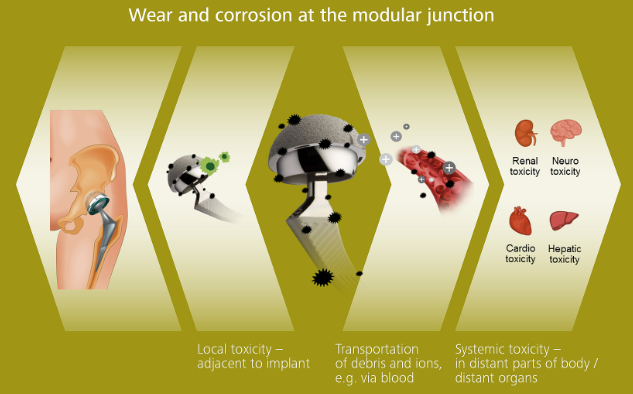Implant Wear Debris and Adverse Reactions
Introduction
Prosthetic devices make a significant difference in people’s lives by restoring mobility. However, during regular use, these devices produce small particles called wear debris. It’s important to understand the impact of wear debris as it can cause harmful reactions in the body. In this article, we explore how wear debris affects prosthetic devices, focusing on inflammation, tissue damage, and implant failure.[1]
The Role of Wear Debris in Inflammation and Implant Failure
Wear debris can trigger immune responses, leading to inflammation, tissue damage, and even potential failure of the implant. Inflammation caused by debris is a common reason why implants fail over time. Immune cells identify and respond to debris by forming Foreign Body Giant Cells (FBGCs). These cells release substances that contribute to the destruction of bone tissue, known as osteolysis. See Figure 2 for a visual representation.[3]

Figure 2. Implant wear generates debris, prompting immune cells such as neutrophils and macrophages to secrete cytokines. These cytokines, in turn, attract more immune cells to the site of inflammation, resulting in the formation of foreign body giant cells. This progressive inflammation process ultimately leads to implant failure.[3]
Understanding Wear Debris Characteristics
Prosthetic devices can have different types of debris, including metallic, polyethene, ceramic, and cement debris. In addition to their composition, certain characteristics of wear debris play a crucial role:
Particle Size: Debris particles come in various sizes, ranging from tiny nanometers to larger micrometers. The size of the particles affects how they interact with immune cells and their potential to cause inflammation.
Particle Shape: Wear debris particles can have different shapes, such as round, irregular, or elongated. The shape of the particles influences how they interact with immune cells and the surrounding tissues.
Surface Properties: The roughness and chemical composition of debris particles affect their compatibility with the body and their ability to trigger immune responses.
Biological Reactivity: Metallic debris, in particular, can induce biological reactions in the surrounding tissues. This includes activating immune cells, promoting inflammation, and potentially damaging nearby cells and tissues.[4]
The Significance of Examining Wear Debris in Orthopedic Implants
The scientific community recognizes the importance of studying wear particles in orthopedic implants. As the number of joint replacement surgeries increases, it becomes crucial to understand the characteristics of wear debris, especially metallic particles. Analyzing the shape, properties, and reactivity of these particles provides valuable insights into how they contribute to implant degradation, ion release, and corrosive activity. This knowledge helps researchers develop strategies to improve implant performance and enhance patient outcomes.[5]
Awareness of wear debris in prosthetic devices is crucial for healthcare professionals and patients alike. Understanding its impact on inflammation, tissue damage, and implant failure allows for informed decision-making when choosing and designing prosthetic devices. By exploring the characteristics and interactions of wear debris, we can strive towards advancements that maximize the longevity and compatibility of prosthetic implants, ultimately improving the quality of life for those who rely on them.
References
- Gilbert, J. L., & Urban, R. M. (2010). Corrosion of metal orthopaedic implants. In Orthopaedic implant corrosion (pp. 3-17). Woodhead Publishing.
- https://www.ceramtec-medical.com/en/infocenter/ceranews/health-economics-policy/immunological-response-of-metal-containing-implants-under-scrutiny
- Gardner, A.B. et al. (2013) ‘Biomaterials-based modulation of the immune system’, BioMed Research International, 2013, pp. 1–7.
- Wu, X. et al. (2022) ‘Characteristics of particles and debris released after implantoplasty: A comparative study’, Materials, 15(2), p. 602.
- Billi, F. et al. (2009) ‘Metal wear particles: What we know, what we do not know, and why’, SAS Journal, 3(4), pp. 133–142.




Be the first to comment